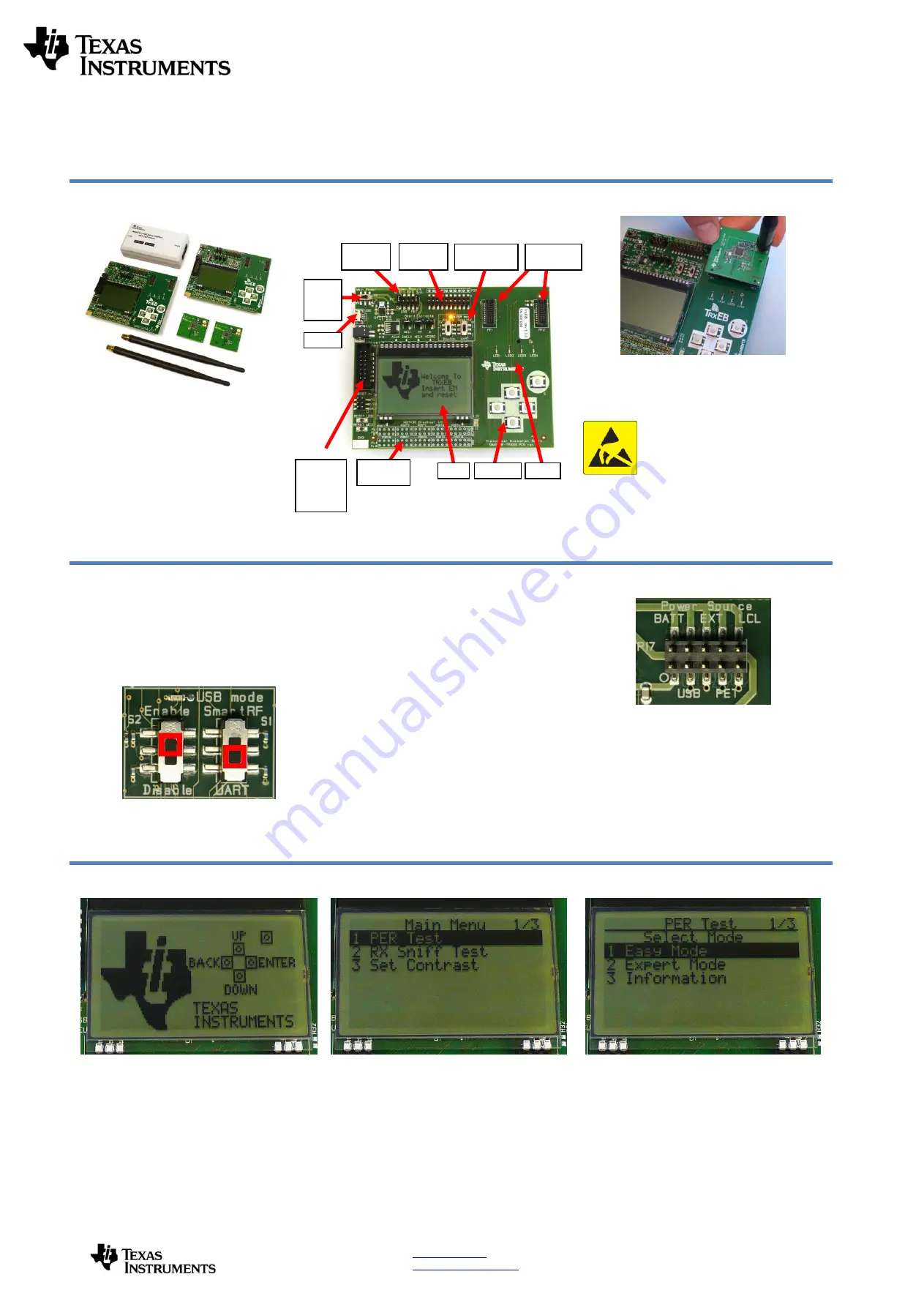
SWRU317
March 2012
Web sites:
www.ti.com/lprf
E2E Forum:
www.ti.com/lprf-forum
Make sure to subscribe to the Low-Power RF
Newsletter to receive information about updates to
documentation, new product releases, and more.
Sign up on the TI web pages.
CC1125 Development Kit Quick Start Guide
Opening the Box and Running the Packet Error Rate Test
1. Kit Contents
2 x SmartRF Transceiver Evaluation Boards
(TrxEB)
2 x CC1125 ETSI Cat1 868 MHz Boards
(CC1125EM-CAT1-868)
2 x W5017 Pulse Antennas
1 x MSP430 Debug Probe (FET)
2 x Micro USB Cables
1 x Standard USB Cable
1 x 14-pin Flat Cable
4 x 1.5 Volt AA Batteries
Documentation
2. TrxEB Overview
3. Plug the EM into the TrxEB
Insert a CC1125EM board into the TrxEB as
shown above. Connect the antenna to the SMA
connector on the EM.
Caution!
The kit contains ESD sensitive
components. Handle with care to
prevent
permanent
damage.
To
minimize risk of injury, avoid touching
components
during
operation
if
symbolized as hot.
The hardware in this kit is tested and complies with
ETSI/R&TTE over temperature from 0 to +35°C. The
W5017 whip antenna from Pulse has a gain of 2 dBi.
The CC1125 is a receiver category 1 device, c.f. ETSI
EN 300 220-1, §4.1.1.
4. Select Board Mode
Use the switches S1 and S2 to select the
operating mode of the board. For the sake of this
quick start guide, please select “Enable” and
“UART”. This configuration will make it possible
to communicate directly with the MSP430 over a
virtual COM port on the PC.
5. Power Options
There are several ways of applying power to the
TrxEB.
USB (5V)
2 x 1.5 V AA batteries
External regulated power supply
MSP430 debugger
For the batteries and USB, there are voltage
regulators on the TrxEB that will set the on-board
voltage to 3.3 V.
Warning!
To minimize risk of injury or property
damage, never use rechargeable batteries to
power the board. Always select a power source
that is suitably rated for use with this EVM,
not
exceeding 3.6 VDC, with a current output
rating between 0 and 500 mA.
6. Select Power Source
Depending on the power source, make sure you
connect jumpers to the appropriate pins on the
“Power Source” header. For instance, if you use
batteries, use a jumper to short-circuit pin 1 and
2 on the header. See back side of board for
explanation of the jumpers..
Note that there should only be one active
power source at any one time. Do not leave
the EVM powered when unattended.
7. Welcome Screen
Turn on power with the Main Power switch. You
should now see the Texas Instruments logo and
a short description of the buttons on the LCD.
Pushing any of the five buttons on the board will
take you to the main menu.
NB! If you don’t see anything on the screen
make sure the mode switches are in the
correct positions (see step 4 above).
8. Packet Error Rate Test
Select the PER (Packet Error Rate) test by
highlighting the selection using the up/down
buttons. Confirm your selection by pressing
Enter (right button).
9. Select Test Mode
The PER test can be run is several modes. Easy
Mode sets up a one-way test and uses default
settings. This test is convenient for practical
range testing.
The other test modes are described in the
“
Software Examples for CC112x, CC11xL and
CC1101 User’s Guide
”.
To proceed, highlight “Easy Mode” and press
Enter (right button).
EM
Connectors
MSP430
Breakout
USB
EM
Breakout
Main
Power
Switch
Power
Selection
Board Mode
Switches
LCD
Buttons
LEDs
MSP430
Debug
Interface
connector


























